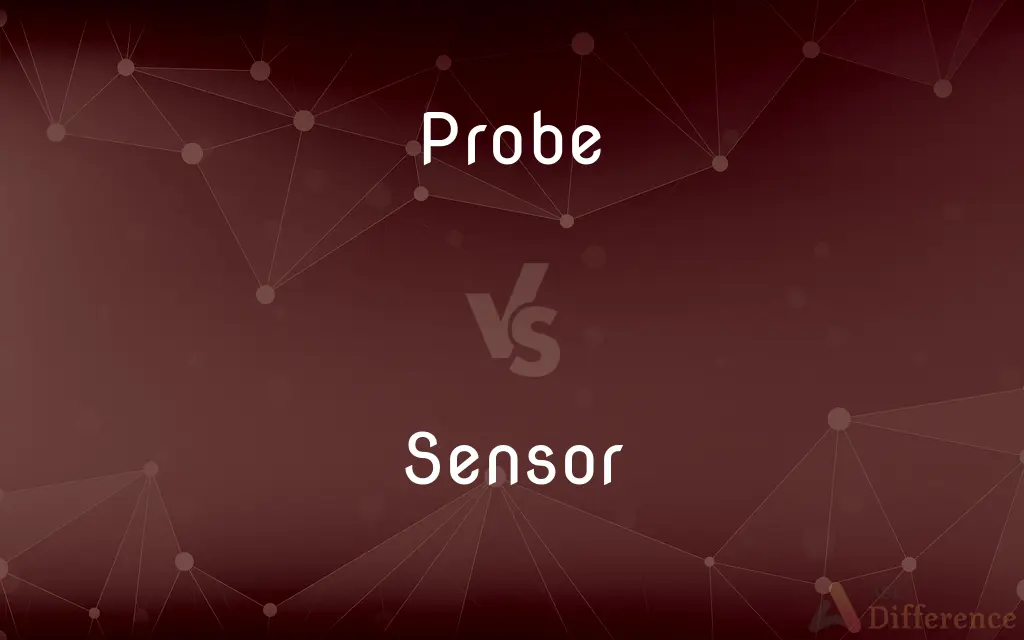Probe vs. Sensor — What's the Difference?
By Maham Liaqat & Fiza Rafique — Updated on February 26, 2024
A probe is a device or instrument used to investigate or measure conditions, often physically inserted into environments, while a sensor is a component or device that detects changes in physical conditions or quantities, converting them into signals.

Difference Between Probe and Sensor
Table of Contents
ADVERTISEMENT
Key Differences
Probes are tools designed for direct interaction with the environment or substance they are measuring. They can be as simple as a thermometer inserted into a substance to measure temperature or as complex as a space probe sent to study distant planets. Probes often physically penetrate or come into close contact with the object of study, allowing for direct measurement or collection of data. Sensors, in contrast, are devices or components that detect and respond to some type of input from the physical environment. The input could be light, heat, motion, moisture, pressure, or any one of a variety of other environmental phenomena. Sensors convert these inputs into electrical signals, which can be measured, interpreted, and used by other devices or systems.
A probe is often a standalone instrument that might contain sensors as part of its assembly, sensors are typically integrated into larger systems to provide data or inputs. For example, a temperature probe used in a laboratory might use a thermocouple sensor to detect temperature changes, which it then converts into a readable measurement on a display.
The use of probes is common in fields like medicine, where biopsy probes take tissue samples; in environmental science, where soil probes measure moisture levels; and in space exploration, where probes collect data from space. Sensors are ubiquitous in everyday life, from the thermostat that regulates your home's temperature to the motion sensors that turn lights on and off as you enter and leave a room.
The distinction between a probe and a sensor is in their application and functionality. Probes are designed for direct, often invasive, interaction with their subject to collect data or samples. Sensors, however, are the means by which a variety of devices, including probes, detect changes in the environment or in physical quantities, translating these changes into actionable data.
Comparison Chart
Definition
A device used to investigate or measure conditions, often through direct contact.
A device that detects changes in physical conditions or quantities, converting them into signals.
ADVERTISEMENT
Functionality
May contain sensors; designed for direct interaction with the study subject.
Detects and responds to environmental inputs; part of larger systems.
Application
Medicine, environmental science, space exploration.
Used in a wide range of devices, from home appliances to industrial machinery.
Example
Biopsy probe, soil moisture probe, space probe.
Thermocouple, photoresistor, motion sensor.
Interaction
Often physically penetrates or contacts the object of measurement.
Typically does not directly interact with the object but detects environmental phenomena.
Compare with Definitions
Probe
Specific Applications.
Temperature probes are crucial in monitoring and controlling industrial processes.
Sensor
Integrated into Systems.
Sensors in smart homes adjust heating based on room occupancy.
Probe
Physical Interaction.
A biopsy probe collects tissue samples for medical examination.
Sensor
Conversion to Signals.
A temperature sensor converts heat into a readable electrical signal.
Probe
Data Collection.
Oceanographic probes measure salinity and temperature at various depths.
Sensor
Detects Environmental Changes.
The motion sensor activates lights upon detecting movement.
Probe
Can Contain Sensors.
The space probe contained multiple sensors to study the Martian atmosphere.
Sensor
Wide Range of Uses.
Pressure sensors are used in automotive systems to monitor tire pressure.
Probe
Direct Measurement Tool.
The soil probe was inserted into the ground to assess moisture levels.
Sensor
Passive Interaction.
Light sensors detect ambient light levels without direct contact with the light source.
Probe
Physically explore or examine (something) with the hands or an instrument
Hands probed his body from top to bottom
Sensor
In the broadest definition, a sensor is a device, module, machine, or subsystem whose purpose is to detect events or changes in its environment and send the information to other electronics, frequently a computer processor. A sensor is always used with other electronics.
Probe
The act of exploring or searching with a device or instrument
The surgeon's probe of the clogged artery.
Sensor
A device, such as a photoelectric cell, that receives and responds to a signal or stimulus.
Sensor
A device or organ that detects certain external stimuli and responds in a distinctive manner.
Sensor
Any device that receives a signal or stimulus (as heat or pressure or light or motion etc.) and responds to it in a distinctive manner
Common Curiosities
What makes a probe different from a sensor?
Probes are designed for direct measurement or investigation, often containing sensors, while sensors detect and convert environmental changes into signals.
Are probes only used for scientific research?
While commonly used in research, probes are also used in medical, environmental, and industrial applications.
Can a sensor work without a probe?
Yes, sensors can function independently within systems to detect environmental or physical changes.
Is a thermometer considered a probe or a sensor?
A thermometer can be considered a probe when it directly measures temperature, often using a sensor like a thermocouple.
How are sensors powered?
Sensors can be powered by batteries, wired connections, or even energy-harvesting technologies in wireless applications.
What role do sensors play in automation?
Sensors are critical in automation, providing the data necessary for systems to make decisions and take actions without human intervention.
How do sensors communicate their measurements?
Sensors convert detected changes into electrical signals, which can be interpreted by devices or systems.
Can a single probe contain multiple sensors?
Yes, especially in complex applications like space exploration, probes may contain various sensors to measure different conditions.
Are all probes invasive?
While many probes interact directly with their subject, some, like non-contact temperature probes, can measure without physical penetration.
Can probes and sensors be used in consumer products?
Yes, they are widely used in products like smartphones, cars, and home appliances for various functions.
Can probes be used remotely?
Yes, probes like those used in space exploration operate remotely, sending data back to Earth for analysis.
What safety considerations are there for using probes?
In medical or industrial applications, safety considerations include sterility, precision, and minimizing disruption or damage to the subject.
How do probes and sensors contribute to data collection in research?
They are essential tools for collecting accurate, real-time data across a wide range of scientific fields, enhancing research quality and insights.
How has sensor technology evolved?
Sensor technology has advanced significantly, with sensors becoming smaller, more accurate, and capable of detecting a broader range of phenomena.
How do environmental conditions affect sensor accuracy?
Extreme temperatures, humidity, and physical shocks can affect sensor performance; however, many are designed to withstand specific conditions.
Share Your Discovery

Previous Comparison
Tomb vs. Grave
Next Comparison
Professoriate vs. ProfessorateAuthor Spotlight
Written by
Maham LiaqatCo-written by
Fiza RafiqueFiza Rafique is a skilled content writer at AskDifference.com, where she meticulously refines and enhances written pieces. Drawing from her vast editorial expertise, Fiza ensures clarity, accuracy, and precision in every article. Passionate about language, she continually seeks to elevate the quality of content for readers worldwide.














































